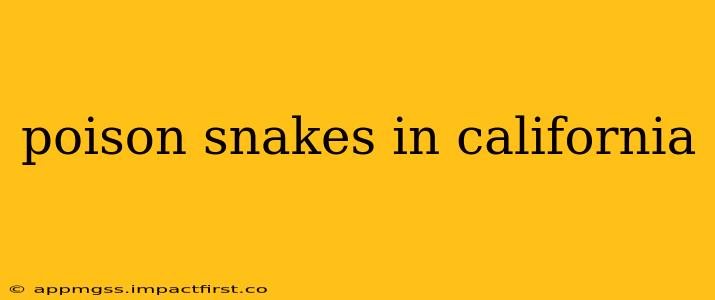California, with its diverse landscapes ranging from deserts to redwood forests, is home to a variety of snakes, some of which are venomous. Understanding which snakes are poisonous and how to react to a bite is crucial for anyone living in or visiting the state. This guide will explore the venomous snakes found in California, providing crucial information on identification, habitat, and first aid.
What types of poisonous snakes are found in California?
California has four main types of venomous snakes: rattlesnakes, coral snakes, the California mountain kingsnake (sometimes mistakenly identified as venomous), and the Baja California rattlesnake. However, rattlesnakes are by far the most common and widespread venomous snake in California.
Rattlesnakes: The Most Common Venomous Snake
Rattlesnakes are easily identifiable by their characteristic rattle at the end of their tail. However, young rattlesnakes may have a poorly developed rattle or even lack one entirely. Several species of rattlesnakes inhabit California, including:
- Southern Pacific Rattlesnake ( Crotalus helleri): Found throughout much of Southern California, this species is relatively large and has a distinctive pattern.
- Western Diamondback Rattlesnake (Crotalus atrox): This is a large, aggressive rattlesnake with a prominent diamond pattern found in the southern and central parts of the state.
- Great Basin Rattlesnake (Crotalus lutosus): Inhabiting eastern California, this species is often lighter in color than other rattlesnakes.
- Northern Pacific Rattlesnake (Crotalus oreganus): Found in Northern and Central California, this species exhibits significant variation in color and pattern.
Coral Snakes: A Less Common Threat
Coral snakes are less common in California than rattlesnakes and generally more shy. They possess a potent neurotoxic venom, but bites are rare due to their secretive nature. Identifying a coral snake requires careful observation of its distinctive banding pattern. Remember the rhyme: "Red touch yellow, kill a fellow; red touch black, venom lack." This rhyme is a helpful but not foolproof method of identification.
California Mountain Kingsnake: Often Mistaken for a Venomous Snake
The California mountain kingsnake (Lampropeltis zonata) is a non-venomous snake often mistaken for a coral snake due to its similar banding pattern. It's crucial to be able to distinguish it from venomous species. The kingsnake's bands tend to be wider and less distinct.
Baja California Rattlesnake: A Southern California Resident
Found in the extreme southern reaches of California, the Baja California rattlesnake (Crotalus scutulatus ) is a highly venomous species that deserves respect.
How can I identify a poisonous snake in California?
Identifying venomous snakes requires caution and a good understanding of their physical characteristics. Look for key features such as:
- Rattles: The most obvious indicator of a rattlesnake.
- Triangular Head: Venomous snakes often have a distinctly triangular-shaped head.
- Heat-Sensing Pits: Located between the eye and nostril in some species, these pits detect infrared radiation, helping the snake locate prey.
- Pupil Shape: Pit vipers (including rattlesnakes) typically have elliptical pupils.
- Color and Pattern: While patterns vary within species, certain colorations and patterns are common to venomous snakes in California.
What should I do if I encounter a poisonous snake?
The best approach when encountering a snake is to avoid it. Give the snake plenty of space and slowly back away. Do not attempt to handle it or try to kill it. If bitten, seek immediate medical attention.
What are the symptoms of a poisonous snake bite?
Symptoms of a venomous snakebite can vary depending on the species and the amount of venom injected. Common symptoms include:
- Pain at the bite site: This can range from mild to severe.
- Swelling: Swelling may develop rapidly around the bite area.
- Nausea and vomiting: These symptoms are common after a venomous snakebite.
- Difficulty breathing: In severe cases, breathing problems can occur.
- Numbness or tingling: Neurotoxic venom can cause these sensations.
- Bleeding disorders: Hemorrhagic venom can lead to bleeding problems.
What first aid should I administer for a poisonous snake bite?
First aid for a snakebite focuses on slowing the spread of venom:
- Stay calm: Panic can worsen the situation.
- Call emergency services immediately: This is crucial for getting appropriate medical treatment.
- Immobilize the bitten limb: Keep the affected limb still to minimize venom spread.
- Remove any jewelry or tight clothing: Swelling may occur rapidly.
- Keep the bite site below the level of the heart: This can help to slow the spread of venom.
- Do not apply a tourniquet or attempt to suck out the venom: These methods are ineffective and can cause further harm.
- Do not cut the wound: This is unnecessary and can increase the risk of infection.
Where can I find more information about poisonous snakes in California?
For more detailed information on snake identification, safety, and treatment, consult reputable sources such as the California Department of Fish and Wildlife, local herpetological societies, and your physician.
Disclaimer: This information is intended for educational purposes only and should not be considered medical advice. Always seek professional medical attention for any snakebite. This article is written by a seasoned wildlife enthusiast and contains information gathered from reputable sources. However, accurate identification of venomous snakes requires expert knowledge; if unsure, always err on the side of caution and avoid contact.
